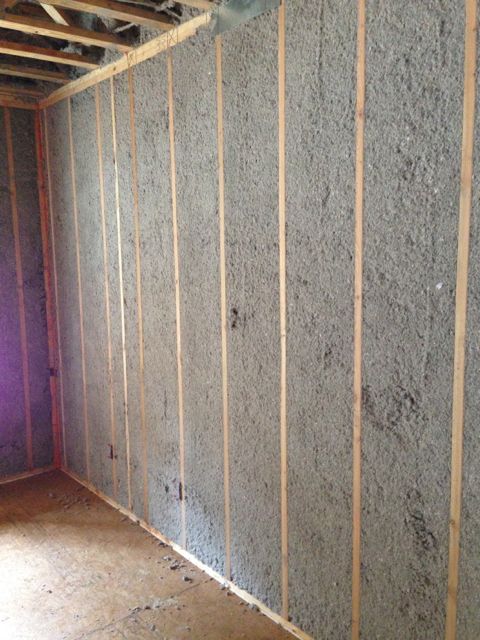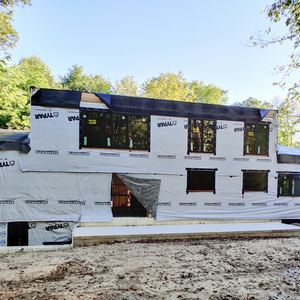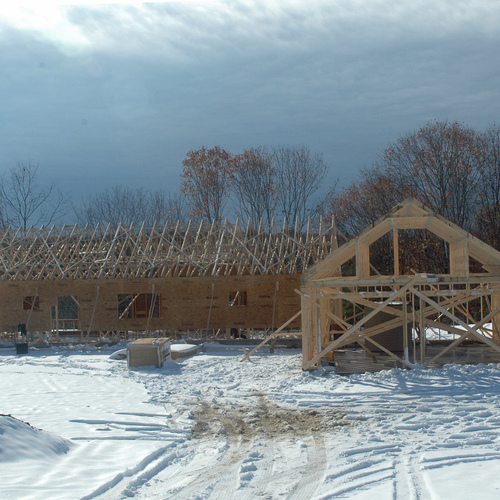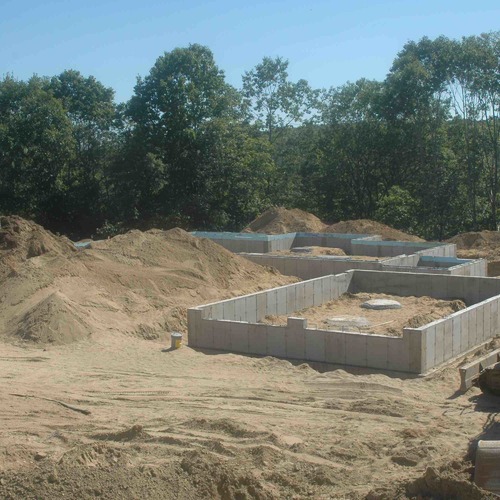Image Credit: Energy Vanguard
Image Credit: Energy Vanguard The devil's in the details, and having a third-party consultant as well as doing commissioning can help you root out problems like this. Someone here knew they were supposed to spray foam at interfaces but didn't understand how to do it so that it would work.
Image Credit: E3 Innovate, Nashville, TN
Want to learn more about building a pretty good house? Sign up for the Sustainable Building Accelerator and learn directly from author and architect Emily Mottram.
My friends up in Maine came up with the concept of the Pretty Good House a few years ago, and I love the idea! Not everyone can or wants to build a LEED Platinum, Living Building Challenge, Passive House. But a lot of architects, builders, and home buyers would like to design, build, and live in houses that are better than the barely legal, code-minimum houses that populate the market.
The Pretty Good House, then, is the way to go.
The 10 essential steps
If you’re interested in designing, building, or living in a Pretty Good House, here are what I consider 10 essential steps you need to take to make it happen. Martin Holladay also came up with a list of 10 items in his article, Martin’s Pretty Good House Manifesto, but you’ll find the list here has a different flavor than his.
It starts with applying the principles of building science, as I’ve been writing since I got into this field. Just put it all together, and you’ve got yourself a Pretty Good House.
1. Spend more time on planning. This was my biggest mistake in the house I built. I got rushed and ended up spending more time building the house and it cost more money as a result. Take all the time you need to get the details right before you move any dirt or lift a hammer. It’ll pay off in the end. Think about everything: orientation on the site; window area, placement, and overhangs; doing things in the proper order… This is especially true for getting the HVAC done right. Most designs don’t leave enough room for proper distribution of heating, cooling, and ventilation. Integrated design is where it’s at!
2. Hire a third-party building science consultant. And get them involved from the very beginning. Choose one with knowledge and experience, someone who knows how to work with contractors and can stand up to them when necessary. A lot of good intentions and good designs get undermined by the crusty contractor who says, “We’ve been doing it this way for 30 years and we’re not going to change now.”
3. Don’t cut corners on controlling water. Design and detail every aspect of the water control layers in your building enclosure. What materials are you going to use? Do you need a vented rainscreen? Do all assemblies have the ability to dry properly and not trap water? Most building failures are due to water.
4. Make sure the building enclosure is airtight. That means you’ll need a blower door test. If testing for airtightness is new to you, do preliminary testing at the predrywall stage if possible. How tight is tight enough? Certainly no more than 3 air changes per hour at 50 Pascals (ach50), but Passive House builders are blowing past the 0.6 ach50 level required by that program.
5. Get the most out of your insulation. One of my earliest articles (Is There a Downside to Lumpy Attic Insulation?) was about how badly your insulation can perform just by how it’s distributed. An extension of the same principle is that even a small weakness in your building enclosure’s insulation can have a mind-blowing effect on performance. In short, a uniform layer with a lower R-value beats really thick insulation interspersed with little to no insulation. It’s the thermal bridging, stupid! If you can get continuous insulation on all parts of the building enclosure, that’s a big step toward getting a Pretty Good House. (If you want to go deeper, learn about the layers and pathways of heat flow.)
6. Pay extra attention to rough openings. Certainly this is true for controlling the flow of heat because windows have a lower R-value than the surrounding walls. Even more important, though, is that water leaks usually happen at the openings, so get those flashing details right! And of course, it’s easy to make a significant reduction in your air leakage by sealing the rough openings… or missing your target because you didn’t.
7. Hire the right company to design your HVAC system. That company might be the same company that installs your HVAC system. There are a few out there that are competent at this. What happens way more often than it should, though, is that when the installer also designs, you end up with duct disasters like this. What you really want is something like the one shown in this link.
8. Get the HVAC distribution systems inside the building enclosure. Forced air heating and cooling dominates the type of distribution in most homes in North America. Even with a perfectly designed and installed duct system, putting those ducts in an unconditioned attic can add 15% to your air conditioning bill. From a performance perspective, HVAC distribution needs to be inside the building enclosure. You can do it with ductless minisplits, plenum trusses, and other techniques. Just do it.
9. Install a good whole-house ventilation system. Airtight homes need mechanical ventilation. Balanced ventilation, which both exhausts stale air from the house and brings in an equal amount of outdoor air, is the best. I wrote a pretty thorough article called Choosing a Ventilation Strategy in the Journal of Light Construction last year.
10. Commission the building. Getting a good design is a start. Implementing that design is not the finish. Making sure that the the various assemblies and systems work as designed is where you end, and that process is called commissioning. Just because you can see caulk and spray foam in an enclosure doesn’t mean it’s airtight. (See above photo.) Just because a duct system is beautiful doesn’t mean it moves the right amount of air. These things and more need to be tested at the end of the construction process.
I haven’t mentioned every single thing you need to do to build a Pretty Good House here. As always, the devil is in the details. Click on the links above and below to learn more about those details. If you follow these 10 steps, though, your chances of a good outcome are greatly improved. Disregard the advice here, and you end up with a house that makes it into one of my Halloween articles. Bwaahaaahaaahaaaahaaaaaaa!
Allison Bailes of Decatur, Georgia, is a speaker, writer, energy consultant, RESNET-certified trainer, and the author of the Energy Vanguard Blog. Check out his in-depth course, Mastering Building Science at Heatspring Learning Institute, and follow him on Twitter at @EnergyVanguard.
Weekly Newsletter
Get building science and energy efficiency advice, plus special offers, in your inbox.
















One Comment
Further PGH discussions
We just had the first session of our 2015-16 Building Science Discussion Group (from whence PGH sprang) last night. One of the ideas we talked about last spring was creating a separate budget for the shell and the rest of the project, as a way of protecting the shell details as budgets tighten.
One of our regulars came up to me after the session and told me he'd had a successful outing with this approach over the summer. I think it's a good strategy both for designers and contractors working with clients who may not have a good grounding in current best practices, and also for clients who are concerned their contractors may try to sacrifice details to make the numbers work.
Log in or create an account to post a comment.
Sign up Log in